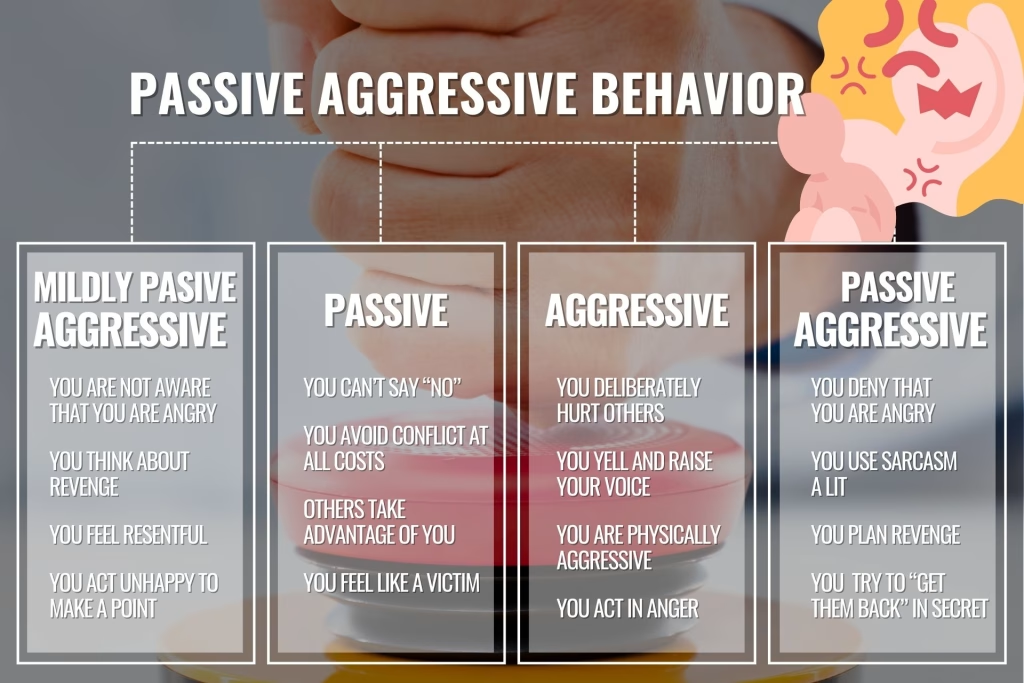Unmasking Passive Aggression: Hidden Hurts and Healing Paths
Passive aggression – a term we’ve all heard, but do we truly understand its depths? In today’s blog post, we’ll dive into this complex behavior, exploring its causes, impacts, and most importantly, how to navigate relationships affected by it.
Whether you’re dealing with a passive-aggressive colleague, family member, or even recognizing these tendencies in yourself, this guide aims to shed light on the shadows of passive aggression.
The Silent Storm: What is Passive Aggression?
Passive aggression resembles a storm that never quite breaks. This behavior pattern manifests through indirect expressions of negative feelings, rather than openly addressing them. Consider the co-worker who agrees to help but subsequently fails to complete the task or the partner who claims to be “fine” despite clear signs of upset.
At its core, passive aggression serves as a coping mechanism. Individuals use this approach to express anger, frustration, or resentment without directly confronting the source of these feelings. While it might seem less harmful than outright aggression, passive aggression can be just as damaging to relationships and personal well-being.
Roots of Resentment: Understanding the Causes
To effectively address passive aggression, we must first understand its origins. Like any behavior, passive aggression develops from complex personal histories and learned behaviors.
One common root of passive aggression stems from childhood experiences. Children who grow up in environments where expressing emotions openly is discouraged or punished may learn to hide their true feelings. As they grow older, these individuals might struggle to communicate their needs and frustrations directly, resorting instead to passive-aggressive behaviors.
Another contributing factor can be low self-esteem. People who don’t feel confident in asserting their needs might turn to passive aggression as a way to exert control without risking direct confrontation. It becomes a shield, protecting them from potential rejection or conflict.
Furthermore, societal and cultural norms can play a role. In some cultures, direct expression of negative emotions is considered impolite or inappropriate. This can lead individuals to develop indirect ways of expressing their discontent, inadvertently fostering passive-aggressive tendencies.
Experiences of conflict or trauma can also contribute to the development of passive-aggressive behaviors. If someone has been hurt or punished for expressing anger directly in the past, they might subconsciously adopt passive aggression as a safer alternative.
Notably, passive aggression doesn’t always stem from a conscious choice. Many people who exhibit these behaviors aren’t fully aware of their actions or the impact they have on others. This lack of awareness can make addressing the issue challenging, but understanding serves as the first step toward change.
Spotting the Signs: How to Identify Passive Aggression
Recognizing passive aggression can be tricky. After all, its very nature is to be indirect and sometimes subtle. However, several telltale signs can help you identify this behavior in others or even in yourself.
One common indicator is a discrepancy between what someone says and what they do. A passive-aggressive person might agree to plans or commitments verbally, but their actions tell a different story. They might consistently arrive late, “forget” important dates, or find excuses not to follow through on promises.
Another sign is the use of sarcasm or backhanded compliments. Passive-aggressive individuals often use humor or seemingly positive comments to disguise their true feelings. For example, they might say something like, “Nice presentation. I’m sure you did your best with the time you had,” implying criticism while maintaining plausible deniability.
Sulking or withdrawing emotionally is another common passive-aggressive tactic. Instead of expressing their displeasure directly, a person might become distant, give the silent treatment, or refuse to engage in meaningful conversation.
Procrastination and intentional inefficiency can also be forms of passive aggression, especially in work or household contexts. A passive-aggressive person might deliberately perform tasks poorly or slowly as a way of expressing their resentment without openly refusing to do the work.
Lastly, passive-aggressive individuals often play the victim. They might frequently complain about feeling unappreciated or misunderstood, without taking steps to address the underlying issues directly.

The Ripple Effect: Psychological Impact on the Recipient
Being on the receiving end of passive aggression can be emotionally draining and psychologically damaging. The indirect nature of the behavior often leaves recipients feeling confused, frustrated, and even questioning their perceptions.
One of the most significant impacts is the erosion of trust. When someone consistently says one thing but does another, it becomes difficult to rely on their words or actions. This can lead to a constant state of uncertainty in the relationship, whether personal or professional.
Passive aggression can also trigger feelings of guilt or self-doubt in the recipient. The aggressor might frame situations in a way that makes the other person feel responsible for their negative emotions. This can lead to a cycle of the recipient trying harder to please the passive-aggressive individual, often at the expense of their well-being.
Moreover, dealing with passive aggression can be incredibly frustrating. The inability to address issues directly can leave the recipient feeling powerless and angry. Over time, this frustration can turn into resentment, further damaging the relationship.
The subtle nature of passive aggression can also make it difficult for recipients to seek support or validation from others. The behavior might not be obvious to outsiders, leading to feelings of isolation and self-doubt.
In professional settings, passive aggression can significantly impact productivity and team dynamics. It can create a tense work environment, hinder effective communication, and ultimately affect the overall performance of a team or organization.
Breaking the Cycle: Strategies for Dealing with Passive Aggression
While dealing with passive aggression can be challenging, several strategies can help navigate these complex interactions. The key is to approach the situation with patience, understanding, and clear communication.
Recognizing and acknowledging the behavior for what it is marks a crucial first step. By naming passive aggression when you see it, you begin to address it directly. This approach involves calmly highlighting the discrepancy between their words and actions, rather than confronting the person aggressively.
Setting clear boundaries is another essential strategy. Let the passive-aggressive individual know what behavior is acceptable and what isn’t. Be specific about your expectations and the consequences of not meeting them. This clarity can help reduce the ambiguity that passive-aggressive behavior often thrives on.
When communicating with a passive-aggressive person, try to use “I” statements instead of “you” statements. For example, instead of saying, “You always forget to do what you promise,” try, “I feel frustrated when tasks aren’t completed as agreed.” This approach focuses on your feelings and experiences rather than placing blame, which can help reduce defensiveness.
Maintaining calm and composure when dealing with passive aggression proves beneficial. Responding with anger or frustration can escalate the situation and reinforce the passive-aggressive behavior. Instead, try to respond with assertiveness and emotional neutrality.
Encouraging open communication can also be helpful. Create opportunities for the passive-aggressive individual to express their feelings directly. This might involve asking open-ended questions or explicitly inviting them to share their thoughts and concerns.
In some cases, offering alternatives to passive-aggressive behavior can be effective. If someone tends to withdraw or give silent treatment, suggest more constructive ways they could express their displeasure or needs.
Remember, changing ingrained behavior patterns takes time and effort. Be patient with both yourself and the passive-aggressive individual as you work towards more open and honest communication.

Self-Reflection: Recognizing Passive Aggression in Yourself
While it’s often easier to spot passive aggression in others, it’s equally important to look inward and examine our own behaviors. Self-awareness is the first step towards personal growth and improving our relationships.
Start by paying attention to your own patterns of behavior, especially in situations where you feel angry, frustrated, or resentful. Do you find yourself agreeing to things you don’t want to do and then finding ways to avoid following through? Do you use sarcasm or backhanded compliments to express your displeasure indirectly?
Consider your communication style. When you’re upset, do you address the issue directly, or do you tend to withdraw, sulk, or find indirect ways to express your feelings? Reflect on your childhood experiences and how you learned to handle negative emotions. Were you encouraged to express your feelings openly, or did you learn to suppress them?
Paying attention to the feedback you receive from others can provide valuable insights. If people in your life often express confusion about your true feelings or frustration with your behavior, it might indicate that you’re engaging in passive-aggressive communication.
If you recognize passive-aggressive tendencies in yourself, don’t be discouraged. Awareness is the first and most crucial step towards change. Consider seeking the help of a therapist or counselor who can provide tools and strategies for developing more direct and healthy communication patterns.
The Road to Recovery: Healing from Passive Aggression
Whether dealing with passive aggression in others or working to change your behavior, the path to healthier relationships involves commitment, patience, and often professional support.
For those on the receiving end of passive aggression, prioritizing your emotional well-being is crucial. Set clear boundaries, practice self-care, and don’t hesitate to seek support from friends, family, or a mental health professional. Remember, you’re not responsible for someone else’s behavior but can control how you respond to it.
If you’re working to overcome your passive-aggressive tendencies, be kind to yourself. Change takes time, and setbacks are a normal part of the process. Focus on small, achievable goals in your communication and celebrate your progress.
Developing assertiveness skills can be incredibly helpful in overcoming passive aggression. This involves learning to express your needs, feelings, and opinions directly and respectfully. Consider taking an assertiveness training course or working with a therapist to develop these skills.
Mindfulness practices can also be beneficial. By becoming more aware of your thoughts and emotions in the moment, you can learn to recognize and address negative feelings before they manifest as passive-aggressive behavior.
For couples or families dealing with passive aggression, couples therapy or family counseling can provide a safe space to work through communication issues and develop healthier interaction patterns.
Building Bridges: Fostering Open Communication
Ultimately, the goal in addressing passive aggression is to create an environment of open, honest communication. This involves building trust, practicing empathy, and developing the skills to express and receive feedback constructively.
In personal relationships, make an effort to create regular opportunities for open dialogue. This might involve setting aside time for check-ins where each person can share their feelings and concerns without judgment. Practice active listening, showing that you value and respect the other person’s perspective even when you disagree.
In professional settings, leaders can foster a culture of direct communication by modeling openness and transparency. Encourage team members to express their ideas and concerns directly, and provide constructive feedback in a supportive manner.
Remember that change doesn’t happen overnight. Building new communication habits takes time and consistent effort. Be patient with yourself and others as you work towards more open and honest interactions.
A Call for Clarity: Embracing Direct Communication
Passive aggression, while common, need not be a permanent fixture in our relationships or work environments.
By understanding its roots, recognizing its signs, and actively working to foster more direct communication, we can create healthier, more fulfilling interactions in all areas of our lives.
To schedule a consultation with Dr. Benejam please contact his office Today!
If you’re struggling with passive aggression, whether in yourself or your relationships, remember that help is available.
Dr. Benejam specializes in helping individuals and couples navigate these complex communication issues.
Don’t let passive aggression continue to cast a shadow over your relationships. Take the first step towards clearer, more honest communication today.
Contact Dr. Benejam’s office to schedule an appointment at 305-981-6434 (Miami Office) or 561-376-9699 (Boca Raton Office) and start your journey towards healthier, more fulfilling relationships. Your path to open, honest communication begins with a single conversation – why not let it start now?





